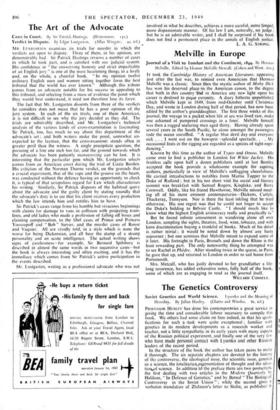The Art of the Advocate
MR. LUSTGARTEN examines six trials for murder in which the verdicts are open to dispute. Three of them, in his opinion, are demonstrably bad. Sir Patrick Hastings reviews a number of cases in which he took part, and is satisfied with our judicial system. His confidence in " the unswerving honesty and strict impartiality of an English jury " is one of the most heartening things in a lively and, on the whole, a cheerful book. " In my opinion twelve ordinary English men and women sitting together form the best tribunal that the world has ever known." Although this tribute "comes from an advocate notable for his success in appealing to this tribunal, and selecting from a mass of evidence the point which they would best understand, it need not therefore lose its force.
The fact that Mr. Lustgarten dissents from three of the verdicts he considers does not mean that he has a poor opinion of the jury system. In each of the six trials, one of them American, it is not difficult to see why the jury decided as they did. The trials are admirably described, and Mr. Lustgarten's technical analysis of the various kinds of cross-examination is fascinating. Sir Patrick, too, has much to say about this department of the advocate's art ; and both writers make the point, somewhat un- expected to the layman, that the cross-examiner stands often in greater peril than the witness. A single precipitate question, the pursuing of a line one inch too far, and the ground towards which the advocate has been patiently manoeuvring can be lost. It is interesting that the particular gem which Mr. Lustgarten selects comes from an American court during the trial of Lizzie Borden. His criticism of the Norman Thorne verdict, on the grounds that a crucial experiment, that of the rope and the-groove on the beam, was conducted without the defence having an opportunity to check it, is typical of that scrupulous regard for Law which characterises his writing. Similarly, Sir Patrick disposes of the habitual query about the advocate and the guilty client by stating roundly that the advocate's duty is to see that his client receives every protection which the law intends him and entitle; him to have.
Sir Patrick's cases range from his humble but vivacious beginnings with claims for damage to vans in collision with projecting tram- lines, and old ladies who made a profession of falling off buses and claiming compensation, to the libel cases of Prince and Princess Youssupoff and " Bob " Sievier, and the murder cases of Rouse and Vaquier. All are vividly told, in a style which is none the worse for being Dickensian, and all bear the stamp of a strong personality and an acute intelligence. The actual writing shows signs of carelessness—for example, Sir Bernard Spilsbury is described in almost the same words in two successive cases—but the book is always interesting and often exciting, and it has the immediacy which comes from Sir Patrick's active participation in the events described.
Mr. Lustgarten, writing as a professional advocate who was not
involved in what he describes, achieves a more careful, more limpid, more dispassionate manner. Of his law I am, naturally, no judge but he. is an admirable writer, and I shall be surprised if his book does not find a permanent place in the annals of English justice.
L. A. G. STRONG.


































 Previous page
Previous page